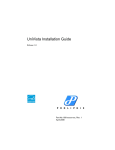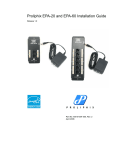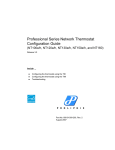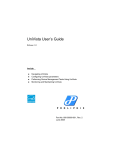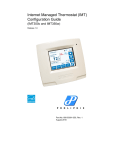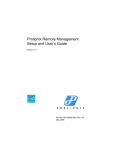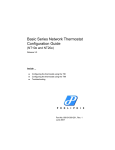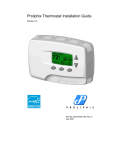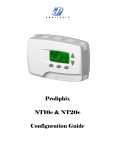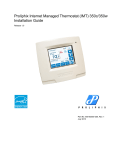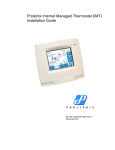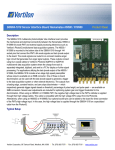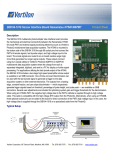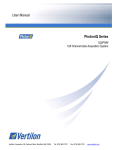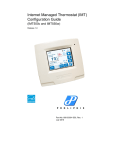Download Model NT10e and NT20e Installation Guide
Transcript
Model NT10e and NT20e Installation Guide Rev 2.0 Page 2 of 9 1. Preparing for Installation CAUTION Do not remove the NT10e/NT20e from the Electro-Static Discharge bag until instructed from this installation guide. The NT10e/NT20e is extremely sensitive to ESD which can cause damage to the electronic components on the NT10e/NT20e circuit module. The ESD bag protects the NT10e/NT20e from ESD. Installation Overview The Proliphix family of thermostats provide a rich set of innovative features including the ability to configure via a graphical interface locally or from any remote location. There are several steps involved to physically install the unit, configure the required network settings and remote access. This document covers the physical installation only. For configuration or remote access refer to the user guides. ¾ If you are replacing an existing thermostat, mount the NT10e/NT20e in place of the existing one if possible. If you are installing the NT10e/NT20e in a new location follow these guidelines: ¾ You will need a #1 or #2 Phillips head screwdriver (small) and Drill with a 3/16" or 7/32" bit for this installation. ¾ Locate the NT10e/NT20e on an inside wall, about 5 feet (1.5m) above the floor, and in a room that is used often. ¾ Install the CAT5, CAT5E or CAT6 cable from wiring center to location of NT10e/NT20e. ¾ Do not install the NT10e/NT20e where there are unusual heating conditions, such as: sunlight, near a lamp, radio, television, radiator register, or fireplace; near hot water pipes in wall; near a stove on the other side of the wall. ¾ Do not locate in unusual cooling conditions, such as: on a wall separating an unheated room; or in a draft from a stairwell, door, or window. ¾ Do not locate in a damp area as this can lead to corrosion and shorten the NT10e/NT20e life. ¾ Do not locate where air circulation is poor, such as: in a corner or alcove; or behind an open door. ¾ Do not install the unit until all construction work and painting has been completed as this may damage the NT10e/NT20e. ¾ Do not mount anything directly below or above the NT10e/NT20e. The wall should be clear from the NT10e/NT20e bottom to the floor and from the NT10e/NT20e top to the ceiling. ¾ This NT10e/NT20e does not require leveling. CAUTION ¾ ¾ ¾ ¾ Turn off electricity to the heating/ cooling unit before installing or servicing. Do not turn electricity back on until all work is completed. Do not jumper wires together to test the system; this may cause harm to your HVAC system and damage the NT10e/NT20e voiding the warranty. All wiring must conform to local codes and ordinances. When pulling cable in the walls/floors/ceilings do not run CAT5 cable next to HVAC cable. Space the cables a minimum one inch apart. Removing the existing Thermostat If you are removing an existing thermostat it is important to pay close attention to the wiring in place and to label each connection as you remove it from the existing thermostat. This will help in making the correct connections to the NT10e/NT20e. Here are the steps that will ensure a proper removal: 1. Follow these steps to ensure proper removal of the existing thermostat: Rev 2.0 Page 3 of 9 2. Turn off power at the HVAC system or the fuse/circuit breaker panel. 3. Remove the cover from the existing thermostat. If the cover does not snap off when pulled firmly from the top or bottom, check for a screw or screws that may be used to lock on the cover. 4. Label the wires one at a time placing the label about 1/2” away from the end of the wire to allow stripping of the ends. 5. As you disconnect each wire, label it with the terminal designation from the existing thermostat. Make sure the wires do not fall back inside the wall. If this is a new installation the wire designations can be obtained from the HVAC installer. 6. Once all wires are labeled, remove the existing thermostat from the wall. 2. Mounting and wiring the NT10e/NT20e Mounting the NT10e/NT20e Base Plate The next set of steps illustrate how to mount the NT10e/NT20e base plate assembly to your wall. Please review all the steps carefully before performing any of the actions. 1. Separate the front from the back of the unit by depressing the bottom center of the unit (at the model label e.g. “NT10e”). 2. Position the base plate for the best appearance. Ensure the position allows you to access and pull the wires through the opening in the base plate. 3. Use a pencil to mark the center of the screw holes on the left side, right side and bottom center of the base plate. 4. Remove the base plate and drill three 3/16" holes in the wall, if drywall, at the locations you marked. For material such as plaster, drill 7/32" holes where marked. 5. Gently tap the enclosed anchors unto the drilled holes until they are flush with the wall. 6. Pull the wires through the base plate and position the base plate over the screw holes. 7. Attach the base plate to the wall using the three enclosed 1" screws included with the NT10e/NT20e. Wiring the Base Plate Terminals for Single Stage HVAC Refer to the labels you placed on the wires you removed from the existing thermostat in the previous steps. 1. Match the letter of your existing thermostat wire with the corresponding terminal letter on the NT10e/NT20e. Refer to Table 1 for terminal compatibility of your system to the NT10e/NT20e. 2. Strip insulation 3/8" (9.5mm) from wire ends. Take care not to damage labels for each wire in handling and push excess wire back into wall so as not to damage while installing. Ensure the ends remain straight. 3. Connect labeled wires only to a terminal post with the corresponding letter as shown in Figure 1 for Single Stage HVAC. 4. If needed, unscrew the terminal post screw that will be used to secure the wires. Insert the wire straight down into the square hole and tighten the corresponding screw down onto the wire. CAUTION When unscrewing the terminal post screws only back out the screw until you feel a slight stop or resistance. Do not back the screw out any further or damage to the terminal block could result. Rev 2.0 Page 4 of 9 HVAC System Cool & Heat Power Fan Control Heat Control Cool Control wire Base Plate Terminal Block Square hole RH RH RC G C G W Y H W2 W1 Y2 Y1 S1+ S1- S1 S2+ S2- S2 1 2 3 4 5 6 Figure 1 Connections for Single Stage HVAC Table 1 lists the standard HVAC terminal label and the Proliphix corresponding label for Single Stage application. Standard Terminal R, RH RC C W, W1 W2 Y, Y1 Y2 G - Proliphix Terminal RH RC C W1 W2 Y1 Y2 G H Description 24VAC 24VAC (not used) Heat Relay (not used) Cool Relay (not used) Fan Relay (not used) Table 1 Terminal Conversion Chart – Single Stage Wiring the Base Plate Terminals for Heat Pump HVAC Follow the same instructions as the Heat Pump HVAC with activate for Heat Reverse Valve (RVS) and make the connections as shown in Figure 2. HVAC System Cool & Heat Power Heat RVS Fan Control Aux Heat Compressor wire Base Plate Terminal Block Square hole G RH W1 Y1 B RH RC C G H W2 W1 Y2 Y1 S1+ S1- S1 S2+ S2- S2 1 2 3 4 5 6 Figure 2 Connections for Heat Pump HVAC Table 2 lists the standard HVAC terminal label and the Proliphix corresponding label for Heat Pump application. Rev 2.0 Page 5 of 9 Standard Terminal R, RH RC C W, W1 Y, Y1 B O G - Proliphix Terminal RH RC C W1 Y1 W2 Y2 G H Description 24VAC Source 24VAC Source (not used) Auxiliary Heat Relay Compressor Relay RVS activate for Heat Relay RVS activate for Cool Relay Fan Relay (not used) Table 2 Terminal Conversion Chart - Heat Pump Remote Sensors The NT20e provides two remote sensor ports. Analog and Thermistor sensors are supported. For a complete list of supported sensors go to the Proliphix.com website. Table 3 illustrates both the Analog and Thermistor sensor connections for the NT20e S1 port. The S2 port is connected similarly. The Analog sensor has polarized connections and must be connected as shown in Table 3. The Thermistor sensor is not polarized. Either lead can be connected as shown in Table 3. DO NOT connect either lead to the S+ terminal. Proliphix Terminal S1+ S1S1 Analog Terminal +V COM T20 Thermistor Terminal (Do not use) either lead either lead Table 3 Remote Sensor S1 Port CAT5 Wiring for Ethernet Network The inside label on the Base Plate provides several color coded wiring schemes for Ethernet CAT5 connections. Match the label number to the Terminal block number for CAT5 color coding as shown in Figure 3. If the other end of the CAT5 cable is connected to a Proliphix EPA-60 or EPA-20 Ethernet Power Adapter, follow the color coding for T568A on the label. Terminal block number 1 2 3 4 5 6 CAT5 T568A color code White-Blue and Blue ends stripped and twisted White-Brown and Brown ends stripped and twisted White-Green Green White-Orange Orange Table 4 Ethernet CAT5 Wiring Rev 2.0 Page 6 of 9 Figure 3 Ethernet CAT5 Wiring Remove the NT10e/NT20e from the electro-static bag. Before mounting the NT10e/NT20e verify the NT10e/NT20e jumpers are configured for your application. The NT10e/NT20e contains jumpers to configure the HVAC power settings. Table 5 shows the possible HVAC power configurations. Most applications use only RH power. The NT10e/NT20e is shipped with the ‘RH Only’ configuration. With J1 inserted RC and RH are connected. The HVAC power configuration determines which HVAC power source RH or RC is switched to turn on the different HVAC systems (cool, heat and fan). The NT10e/NT20e does not take power from the HVAC interface. Figure 4 shows the location of the jumpers on the NT10e/NT20e circuit module. Note that J2 has two possible positions. Figure 4 shows J2 in POS1 position. Justify the jumper downward for POS2 position. Mount the NT10e/NT20e into the wall plate by inserting the top two hinges into the corresponding receptacle holes in the top of the base plate. Snap the bottom of the NT10e/NT20e securely into the base plate. HVAC Power Configuration J2 J1 RH Only (default). POS1 IN Supplies W1, W2, Y1, Y2, G RC Only. POS1 IN Supplies W1, W2, Y1, Y2, G RH and RC utilized POS1 OUT RH supplies W1, W2, G RC supplies Y1, Y2 RH and RC utilized POS2 OUT RH supplies W1, W2 RC supplies Y1, Y2, G NOTE: With J1 inserted RC and RH are connected Table 5 HVAC Power Configuration Rev 2.0 Page 7 of 9 Note: J3 must always be installed Figure 4 NT10e/NT20e Jumper locations 3. Verifying Operation Verifying Heat, Cool and Fan controls To test Heat, perform the following: 1. 2. 3. 4. 5. 6. 7. Verify the HVAC system power is on. Press the middle button labeled ‘HVAC’. Press the middle button labeled ‘Mode’. A menu list will appear. Use the ‘up’ and ‘down’ arrow buttons on the right side to select ‘Heat’. Press the middle button labeled ‘Select’. Press the right button labeled ‘Back’. Press the ‘up’ arrow button until the heat set point is higher than the temperature reading. The heat relay should click and the HVAC system should activate the heat. To test Cool, perform the following: 1. 2. 3. 4. 5. 6. 7. Verify the HVAC system power is on. Press the middle button labeled ‘HVAC’. Press the middle button labeled ‘Mode’. A menu list will appear. Use the ‘up’ and ‘down’ arrow buttons on the right side to select ‘Cool’. Press the middle button labeled ‘Select’. Press the right button labeled ‘Back’. Press the ‘down’ arrow button until the cool set point is lower than the temperature reading. The cool and fan relays should click and the HVAC system should activate the cool and fan. To test the fan separately, perform the following: 1. 2. 3. 4. 5. Verify the HVAC system power is on. Press the middle button labeled ‘HVAC’. Press the left button labeled ‘Fan’. A menu list will appear. Use the ‘up’ and ‘down’ arrow buttons on the right side to select ‘On’. Press the left button labeled ‘Select’. The fan relay should click and the fan should be on. Rev 2.0 Page 8 of 9 Troubleshooting Condition LCD display is blank LCD display is active but no network link indication. HVAC heat does not activate when tested HVAC cool does not activate when tested HVAC fan does not activate when tested Possible Cause Check EPA-60/EPA-20 wiring. Refer to EPA-60 or EPA-20 install guide. Is power applied to EPA-60/EPA-20? Refer to EPA-60 or EPA-20 install guide Check NT10e/NT20e base plate wiring. Check NT10e/NT20e base plate wiring. Check EPA-60/EPA-20 wiring. Is EPA-60/EPA-20 patched to a switch or router? Verify you increased the heat set point higher than the temperature reading and the NT10e/NT20e is in heat mode. Check NT10e/NT20e wiring. Verify the HVAC system is powered. Verify you decreased the cool set point lower than the temperature reading and the NT10e/NT20e is in cool mode. Check NT10e/NT20e wiring. Verify the HVAC system is powered. Check NT10e/NT20e wiring. Verify the HVAC system is powered. 4. Customer Assistance When contacting Proliphix for technical assistance, please have the following information available: ¾ ¾ ¾ Product model and serial number. Type of heating/cooling system (example: gas, oil, or electric; warm air, hot water, heat pump, steam or gravity) Location and number of wires attached to NT10e/NT20e For additional assistance, please contact Proliphix Technical Support using the following: How to reach us: Web: www.proliphix.com Email: [email protected] Telephone: 1-866-IPLIVING Fax: 978-692-3378 Hours of service: 8:00 AM to 8:00 PM Eastern Standard Time Monday to Friday. Extended 7/24 contracts available. Warranty Information Proliphix, Inc. warrants its products to be free from manufacturing defects in materials and workmanship under normal use for a period of 90 days from the date of purchase from Proliphix. Proliphix shall not be liable to honor the terms of this warranty if the product has been used in any other application other than that for which it was intended, or if it has been subjected to misuse, accidental damage, modification, or improper installation procedures. Furthermore, this warranty covers only products which have all original and unaltered markings and labels (serial numbers, model numbers, etc.) of manufacture. This warranty shall be the sole and exclusive remedy to the original purchaser. In no event will Proliphix be liable for incidental or consequential damages (including property and economic) of any kind arising from the sale and use of this equipment. Proliphix is not liable for any claim made by a third party or made by a purchaser for a third party. Proliphix, shall, at its option, repair or replace any product found defective, without charge for parts and labor. Repaired or replaced equipment or parts supplied under this warranty shall be covered only by the unexpired period of the warranty. In no event shall Proliphix’s liability exceed the price paid for the product from direct, indirect, special, incidental, or consequential damages resulting from the use of the product, it's accompanying software, or its documentation. Proliphix offers no refunds for its products. Except as expressly set forth in this warranty, Proliphix makes no other warranties, expressed or implied, nor authorizes any other party to offer any warranty, including any implied warranties of merchantability or fitness for a particular purpose. Any implied warranties that may be imposed by law are limited by the terms of this limited warranty. This warranty statement supersedes all previous warranties. This warranty extends to products purchased directly from Proliphix or an authorized Proliphix dealer, distributor or reseller. Rev 2.0 Page 9 of 9 Material Return Procedure No merchandise may be returned for credit, exchange, or service without prior authorization from Proliphix. To obtain warranty service for Proliphix products, contact Proliphix Customer Service (1-866-IP-LIVING) and request a Return Material Authorization (RMA) number. Products may be returned for credit, exchange, or service with a Proliphix RMA number. Enclose a note explaining the symptoms of the problem, stating the RMA number, and the name, address and phone number of the company or individual contact. Authorized returns must be shipped prepaid to Proliphix at; Proliphix, Inc. Suite #1 66 Tadmuck Road Westford, MA 01886 The RMA number must be clearly marked on the outside of the package. Products received without an RMA number or without shipping prepaid will be subject to refusal by Proliphix. Proliphix reserves the right to charge a 15% restocking fee, plus shipping costs on any products returned with an RMA. Return shipping charges following repair of items under warranty shall be paid by Proliphix via standard ground carrier. In the event that repairs are found to be non-warranty, return shipping charges will be paid by the purchaser. FCC Model: NT10e/NT20e Made in the USA This device complies with Part 15 of the FCC Rules. Operation is subject to the following two conditions: (1) this device may not cause harmful interference, and (2) this device must accept any interference received, including interference that may cause undesired operation. CSA Power: 24VDC 45mA 60Hz 48VDC 22mA 60Hz Switched power each contact: 24VAC 2A 60Hz Contents of this document are subject to change without notice.









